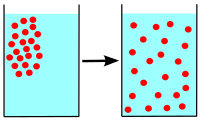
Photo from wikipedia
Abstract Conventional diffusion dialysis has two main shortages, including low processing capacity and serious water osmosis. Pressure-concentration double driven (PCDD) diffusion dialysis was proved to cover the two shortages effectively.… Click to show full abstract
Abstract Conventional diffusion dialysis has two main shortages, including low processing capacity and serious water osmosis. Pressure-concentration double driven (PCDD) diffusion dialysis was proved to cover the two shortages effectively. To further study the PCDD diffusion dialysis, the continuous separation of the common alkali/ metal salt mixture (NaOH/Na2WO4) was realized by adopting it in this work. Results illustrate that 0.04 MPa is an optimum pressure difference. That is because the pressure difference realized the highest recovered NaOH concentration and a high alkali recovery ratio, and a good separation effect were obtained simultaneously. The increment of initial alkali concentration in the feed from 0.5 to 2.0 mol/L can enhance the alkali recovery ratio from 24.93% to 35.15%. As the initial salt concentration in the feed increases from 0.05 to 0.20 mol/L, the recovered NaOH concentration at the operation time of 180 mins improves from 0.24 to 0.36 mol/L, and the alkali recovery ratio increases from 27.86% to 30.34% slowly. Second, a mass transfer mathematical model was established to simulate the continuous PCDD diffusion dialysis separation process. There shows acceptable and satisfactory agreement between the experimental and calculated fluxes, experimental and calculated alkali recovery ratios and salt leakage ratios. The work presented here suggests that the continuous PCDD diffusion dialysis is feasible and promising to be industrialized in the future.
Journal Title: Separation and Purification Technology
Year Published: 2021
Link to full text (if available)
Share on Social Media: Sign Up to like & get
recommendations!